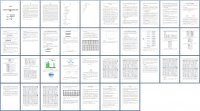不同基线对GPS共视时间比对和共视信号模拟的影响

不同基线对GPS共视时间比对和共视信号模拟的影响(任务书,开题报告,外文翻译,论文15000字)
摘要
随着国防和空间技术的发展与进步, 共视法的应用领域不断扩展。针对不同基线条件下 共视信号仿真与性能测试评估的难题,本文在 共视时间传递原理的基础上,利用 直射信号模拟器,开展不同基线对 共视时间比对和共视信号模拟的影响的研究与设计。
本文首先对 共视时间传递原理进行了介绍,包括 共视的原理、特性以及误差分析。其中,误差分析对于提高 共视时间传递的精度至关重要,所以详细介绍了各种误差的产生,以及共视法对星钟误差、星历误差、电离层延迟误差和对流层延迟误差的消除和削弱,为后续的工作打下基础。
在不同基线的 共视时间比对评估设计中,基线长度和用户观测卫星的仰角决定了对 共视时间比对的影响大小。建立地心地固坐标系,利用用户与卫星间的位置关系,根据表示卫星位置的等价误差对 共视时间比对误差的影响程度的公式,当用户仰角大致相同时,计算不同基线长度下的K值,得出不同基线对 共视时间比对的影响。当两用户的仰角大致相同时,随着基线长度的增加,基线长度对共视时间比对的影响也增大,且与基线长度近似成正比关系。
在不同基线对 共视信号模拟的影响中,利用 直射信号模拟器完成对 共视信号的模拟与实验验证。仿真时刻相同时,运行两次 直射信号模拟器生成的两路信号就是一对 共视信号。分别在零基线、短基线和长基线情况下分析生成的两路 共视信号的仰角、方位角、星历误差、电离层延迟等信息的变化,得出不同基线对 共视信号模拟的影响。零基线情况下,模拟生成的两路 共视信号可看做大致相同,随着基线长度的增加,模拟出的两路 共视信号的星钟误差相同,而观测仰角、方位角、多普勒、星历误差、电离层延迟等信息差别越来越大。 [资料来源:http://Doc163.com]
关键词: 共视;基线;时间比对;信号模拟;模拟器
Abstract
With the development and progress of national defense and space technology, the application field of GPS common-view is expanding. In order to solve the problems of the simulation and performance test of GPS common-view signal, under different baseline conditions, this paper used GNSS direct-signal simulator to carry out research and to design about the effect of different baseline for GPS common-view time comparison and common-view signal simulation.
In this paper, the principle of GPS common-view time transfer is introduced, including the principle, characteristic and error analysis of GPS. Among them, error analysis is very important for improving the accuracy of GPS common-view time transfer. So the generation of various errors is introduced in detail, and the elimination and weakening of satellite clock error, ephemeris error, ionospheric delay error and tropospheric delay error are analyzed. Lay the foundation for the following work.
In the design of GPS common-view time comparison evaluation based on different baseline, the baseline length and the elevation affect the GPS common-view time comparison. The earth centered earth fixed coordinate system is established. According to the position relationship between the user and the satellite and the definition of the impact factor of K said the impact of equivalent error of the satellite position on common-view time comparison error. When the elevation is approximately the same, the K values under different baseline lengths are calculated, and the influence of different baselines on the GPS common-view time comparison is obtained. When the elevation of the two users are approximately the same, K increases as the baseline length increases, and the size of K is approximately proportional to the baseline length.
In the influence of different baseline on the GPS common-view signal simulation, the GNSS direct signal simulator is used to simulate and verify the GPS common-view signal. When the simulation time is the same, the two signals generated by running the GNSS direct signal simulator twice are a pair of GPS common signal. The changes of the elevation, azimuth, ephemeris error and ionospheric delay of the two GPS signals are analyzed at zero baseline, short baseline and long baseline. Then the influence of different baseline on the GPS common-view signal simulation are obtained.In the zero baseline case, two GPS direct signals generated by the simulation can be regarded as roughly the same. With the increase of the baseline length, the satellite clock error of two GPS signal simulated is the same, but the difference of the observed elevation, azimuth, pseudo range, Doppler, ephemeris error and other information of two GPS signals simulated is getting bigger and bigger. [资料来源:https://www.doc163.com]
Key words: GPS common-view; baseline; time comparison; signal simulation; simulator
[资料来源:https://www.doc163.com]

目录
第1章 绪论 1
1.1 引言 1
1.1.1 GPS卫星导航系统概述 1
1.1.2 GPS共视技术 2
1.2 课题来源及研究意义 2
1.2.1 课题来源 2
1.2.2 课题研究目的及意义 3
1.3 GPS共视的发展现状与应用前景 3
1.3.1 GPS共视的国外研究现状 3
1.3.2 GPS共视的国内研究现状 3
1.3.3 GPS共视的应用前景 4
1.4 论文的主要结构和安排 4
第2章 GPS共视时间传递原理 5
2.1 GPS共视的原理 5
2.2 GPS共视的特性 6
2.3 误差分析 6
[来源:http://www.doc163.com]
2.3.1 星历误差 6
2.3.2 对流层时延 7
2.3.3 电离层时延 7
2.4 本章小结 7
第3章 不同基线的GPS共视时间比对评估设计 8
3.1 设计思路 8
3.2 实验方法 8
3.3 实验结果分析 10
3.4 本章小结 11
第4章 不同基线对GPS共视信号模拟的影响 12
4.1 GNSS直射信号模拟器 12
4.1.1 模拟器的软件功能及构成 12
4.1.2模拟器人机交互界面及参数配置 13
4.2 实验方法 19
4.2.1零基线实验 20
4.2.2 短基线实验 23
4.2.3 长基线实验 24
4.3 本章小结 29
第5章 总结与展望 30
5.1 总结 30
5.2 展望 30
参考文献 31
致谢 32
